At a glance
Expert’s Rating
Pros
- Sturdy and sleek all-metal chassis
- Long battery life
- Impressive audio output
- Comfortable keyboard
Cons
- 16:9 screen feels cramped
- Included stylus is too skinny
- Undersized touchpad
- Limited ports all on left side
Our Verdict
The Lenovo Yoga 9i is an exceptional 2-in-1 in many ways, but the 16:9 display is too wide for its intended use as a versatile productivity laptop and tablet.
Best Prices Today
Most of the updates Lenovo made to its flagship 2-in-1 convertible are on the inside, from 11th-gen Intel Core processors and integrated Iris Xe graphics to Thunderbolt 4 support. Outside of these upgrades and slightly rounded corners, the Lenovo Yoga 9i remains similar to the preceding Yoga C940. That’s not necessarily a bad thing. Like the Yoga C940, the Yoga 9i delivers a thin and light yet durable all-metal chassis, a satisfying typing experience, and all-day battery life.
The biggest drawback to the Yoga 9i is the display’s aspect ratio. At 16:9, it’s wide with less room from top to bottom than a 16:10 display affords. More vertical space means less scrolling through long documents and web pages and provides more room to work in general. And, when you move from laptop to tablet mode, the 16:9 display feels awkward for anyone who has used an iPad with its boxy 4:3 screen.
Luckily, the wait for a taller screen will be a short one. Lenovo announced at CES that the next version of the Yoga 9i will feature a 16:10 display. As currently assembled, the Yoga 9i is a stellar 2-in-1, but it might be worth waiting for the update due out this spring if the idea of a taller display intrigues you.
[The best laptops: Premium laptops, budget laptops, 2-in-1s, and more]
Lenovo Yoga 9i Specifications
Lenovo’s 14-inch Yoga 9i line starts at $1,299.99 for a configuration that features an 11th-gen Intel Core i5 CPU, 8GB of RAM, a 256GB SSD, and a Full HD (1920×1280) touch display. Our test system features upgrades to the CPU, RAM, and SSD. The above link will send you to a model that’s similar to our test configuration. The only difference is that it has a 1TB SSD.
- CPU: Quad-core Intel Core i7-1195G7
- Memory: 16GB
- Graphics: Intel Iris Xe
- Storage: 512GB PCIe NVMe M.2 SSD
- Display: 14-inch, 1920×1280 IPS touch
- Webcam: 720p with physical camera shutter
- Connectivity: 2 x Thunderbolt 4 (USB Type-C) ports, 1 x USB SuperSpeed 10Gbps Type-C port, combo audio jack
- Networking: Wi-Fi 6, Bluetooth 5.0
- Biometrics: Fingerprint reader
- Battery capacity: 60 Watt-hours
- Dimensions: 12.57 x 8.51 x 0.61 inches
- Measured weight: 3.07 pounds (laptop), 0.7 pounds (AC adapter)
Lenovo offers both Windows 11 Home and Pro, and our test system features the former. There’s also a display upgrade option that we didn’t get, which trades the baseline Full HD panel rated for 400 nits of brightness for a 4K panel rated for 500 nits. The only other upgrade not included on our test system is a 1TB SSD. We received the 512GB middle child of the three solid-state storage options.
Big sound, wide display
Lenovo offers two color options for the Yoga 9i, one of which comes with a leather lid. If you choose the Shadow Black model, you’ll get the swanky leather cover. We received the Mica option, which is Lenovo’s name for silver. It doesn’t feature the leather lid, unfortunately.
The Mica model is metal from top to bottom. With the added layers needed for the touch display and a sturdy 360-degree hinge, 2-in-1 convertibles weigh more than a comparably sized laptop and the Yoga 9i is no exception to this rule. It weighs a hair over three pounds where many 14-inch laptops weigh closer to 2.5 pounds. Still, the all-metal chassis feels rock-solid with no flex in the keyboard deck and very little flex in the lid.

IDG / Matthew Elliott
The lid is positioned just a bit off centered from the keyboard deck so that when the laptop is closed, it overhangs off the front edge to create a lip that makes it easy to flip open the display. When the display is rotated all the way around into tablet mode, however, the misalignment between the lid and deck is less appealing when gripping the system in tablet mode.
One feature that works equally well in laptop and tablet mode is what Lenovo calls the Rotating Sound Bar — a speaker cleverly built into the system’s 360-degree hinge that projects sound toward you no matter the mode (laptop and tablet as well as tent and presentation modes). With speaker grilles on the front and back of the sound bar, the sound is always moving toward your ears.
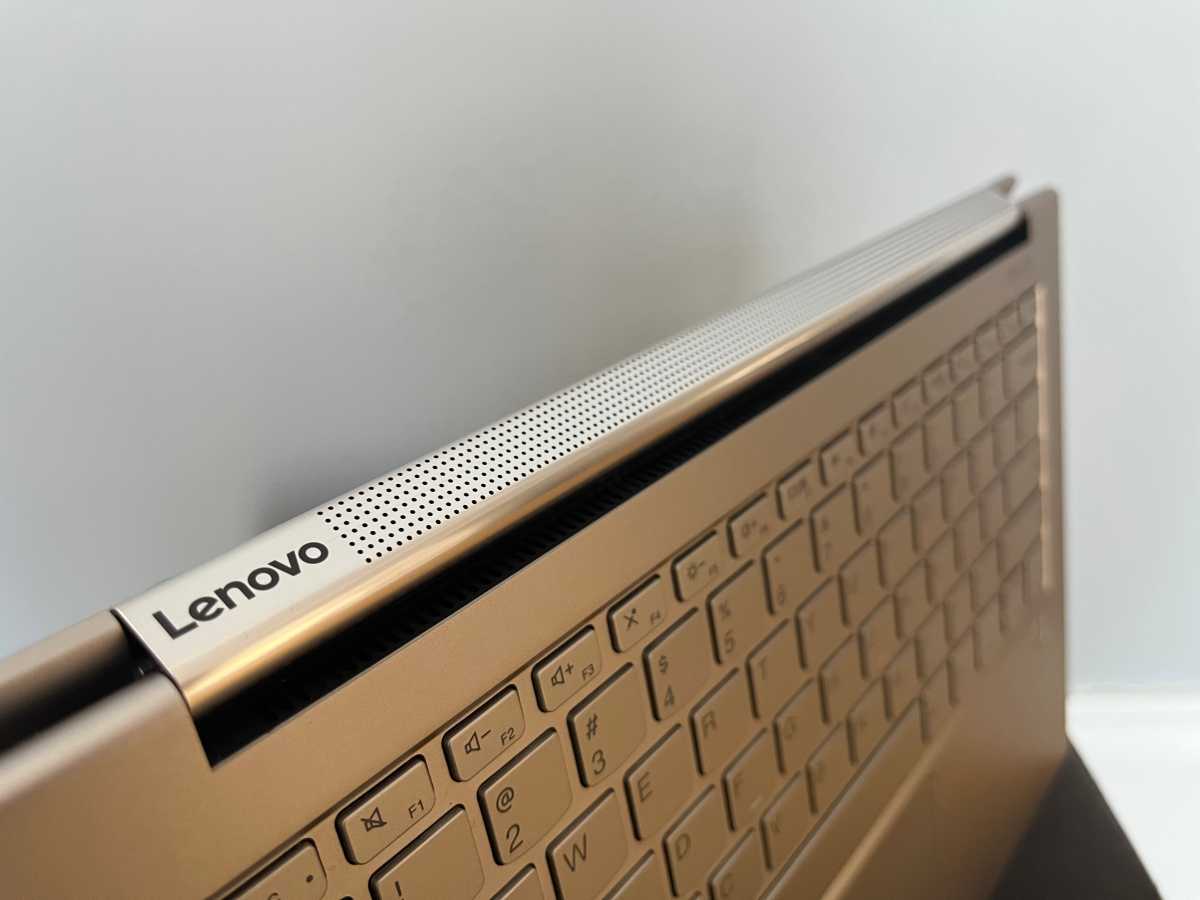
IDG / Matthew Elliott
Lenovo manages to squeeze in a pair of tweeters and two subwoofers that result in surprisingly dynamic output. Most laptops omit subwoofers and their presence can be felt with a bass response that you’ll literally feel in your palms as you type while listening to music. The Yoga 9i’s audio features impressive separation between highs and mids that you usually don’t hear in a laptop — so much so that I hope Lenovo’s idea of putting the speaker into a laptop’s hinge catches on with other manufacturers.
The FHD display looks sharp across its 14 inches and sufficiently bright at its rated 400 nits of brightness. It’s so bright that I wouldn’t recommend the UHD 500-nit upgrade. I measured the FHD panel at a maximum brightness of 410 nits with good uniformity, so it definitely lives up to its claims. Colors appeared accurate and vibrant, and the contrast was excellent with deep blacks and bright whites. Really, my only complaint about the display is its wide 16:9 aspect ratio.
After using a number of laptops in the past year with 16:10 displays, having a taller screen is a much better fit for general use and productivity. I’d argue that entertainment-focused laptops have the only cause to use a 16:9 display, as it’s a better fit for watching movies. Also, the Yoga 9i’s glossy screen coating can produce distracting glare and annoying reflections, but that’s usually the case with 2-in-1s and their touch panels.

IDG / Matthew Elliott
The Yoga 9i features a standard 720p webcam, but it produces a remarkably well-balanced image. Colors and skin tones looked accurate and the image was largely devoid of the graininess I usually see with 720p cams. This is the rare instance where I don’t desire a 1080p upgrade. It lacks IR capability, but Lenovo includes a fingerprint reader for biometric logins. Lastly, the webcam features a physical privacy shield to lend peace of mind when the camera is not in use.
Snappy keyboard, skinny pen
The Yoga 9i’s keyboard is roomy and comfortable but lacks the plush feel of a ThinkPad keyboard. The keys are flat with shallow travel, providing a quick response that’s firmer than that of a ThinkPad. The only keys that are shortened are the up and down arrow keys. Everything else about the layout feels natural. You also get two-level keyboard backlighting, but you’ll need to keep it turned off during daylight hours because you lose the contrast between each silver key and its icon when the backlighting is on and you aren’t typing in a dark room.
The touchpad felt responsive with a pleasing click, but I would’ve liked Lenovo to make it wider to match the aspect ratio of the display. Or, better yet, keep the touchpad as is and change the display to 16:10.
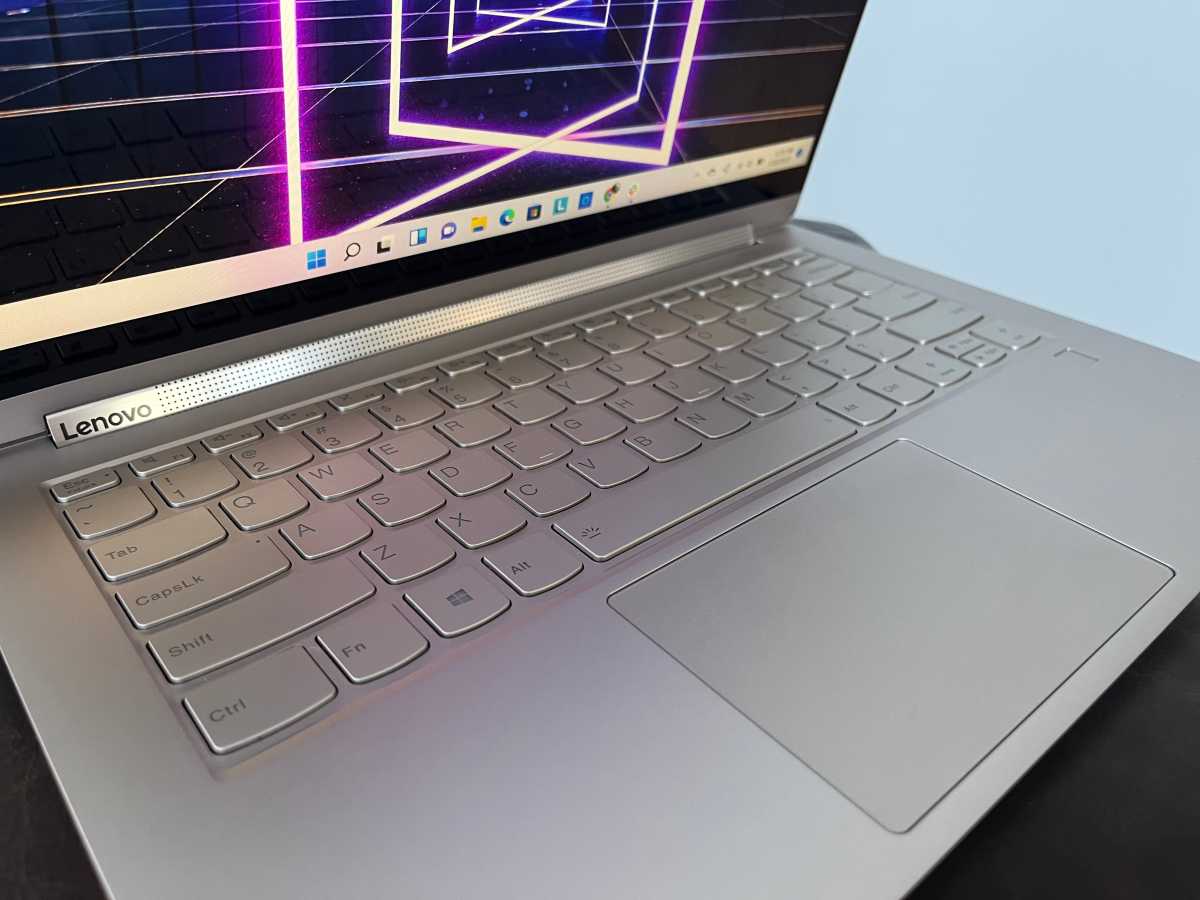
IDG / Matthew Elliott
The Yoga 9i includes a garaged pen that hides in the upper-right corner of the laptop on its back edge. The pen charges in its port and features a rubbery Elastometer tip that creates a bit of friction against the touchscreen that approximates writing on paper instead of a glass surface. The pen is too skinny and difficult to grip, however, which prevents it from providing a natural writing and drawing experience.
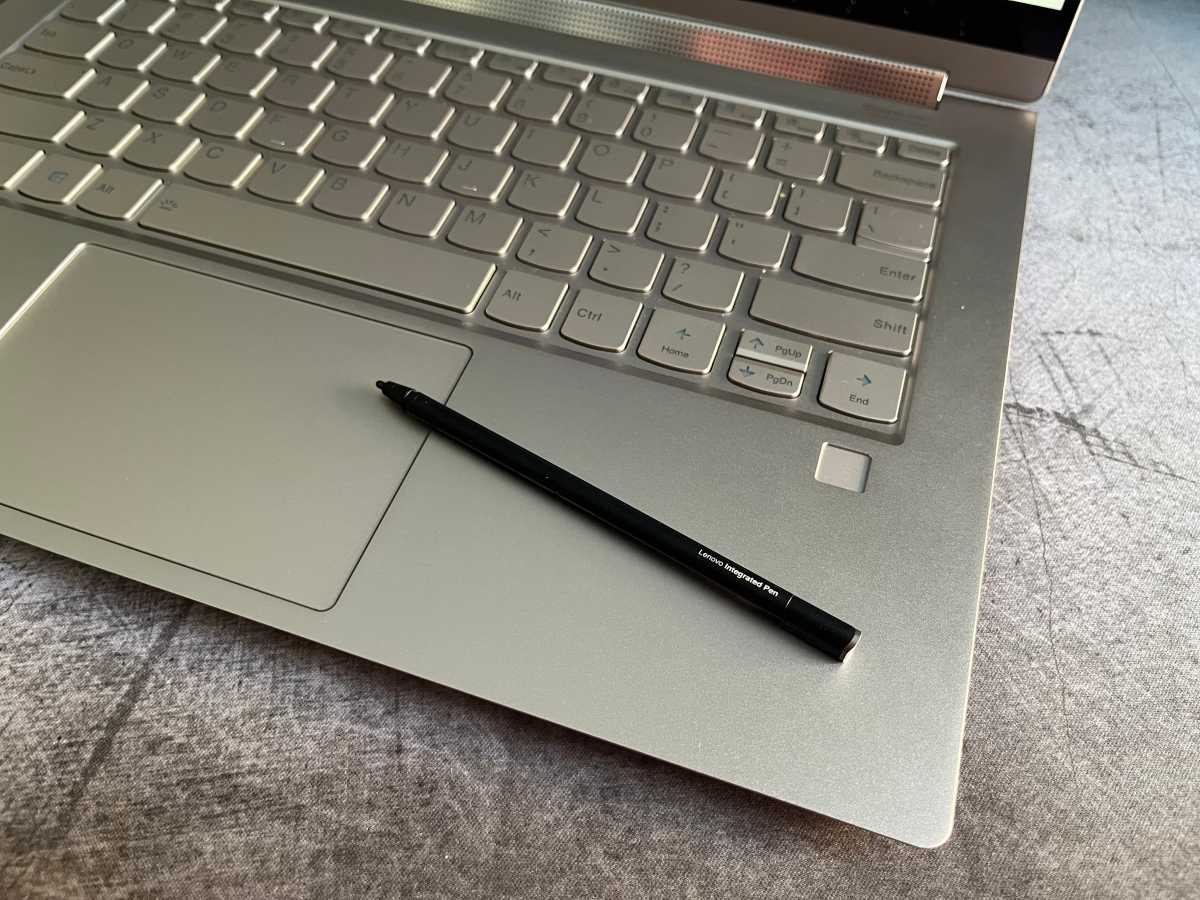
IDG / Matthew Elliott
The Yoga 9i features four ports and they’re all located in a neat row on the laptop’s left edge. There’s a pair of Thunderbolt 4 ports flanked by a USB-A 3.2 Gen 2 port and a combo audio jack. While having two Thunderbolt 4 ports is appreciated, I would’ve liked to have had them split up with one on each side of the Yoga 9, so you could charge the system from both the left and right side. A volume rocker to use while in tablet mode is also on my 2-in-1 wish list but goes missing on the Yoga 9i.
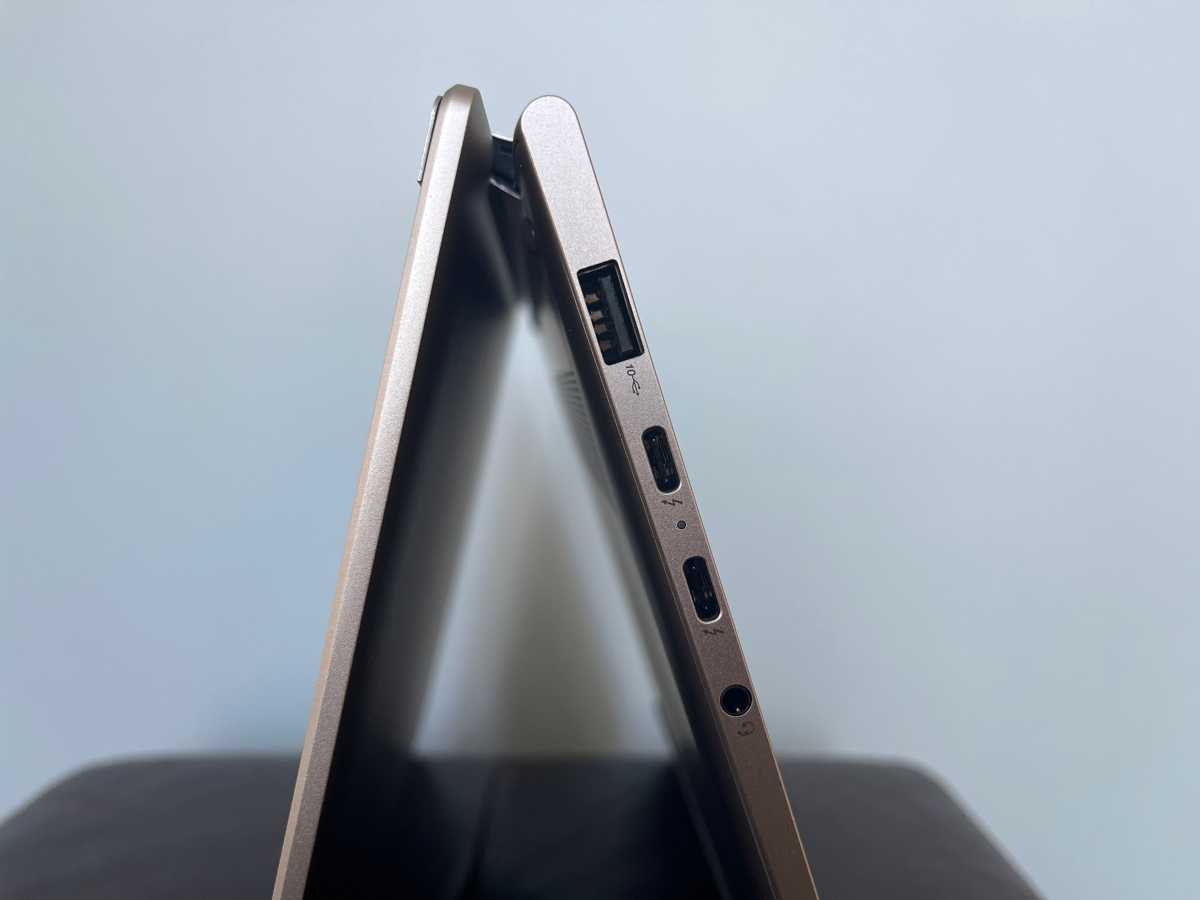
IDG / Matthew Elliott
Yoga 9i performance
Our Yoga 9i features the Core i7-1195G7, 16GB of RAM, integrated Intel Iris Xe graphics, and a 512GB SSD. While models with the Core i7-1195G7 are currently unavailable, you’ll see some with the Core i7-1185G7 chip. Both are quad-core CPUs from Intel’s 11th-gen Tiger Lake family of processors that are nearly identical.
We compared the Yoga 9i against other premium 2-in-1s. HP gets two entries in the Intel-based HP Spectre x360 14 and AMD-based HP Envy x360 15. We also included Dell’s premium XPS 13 2-in-1 and the midrange Dell Inspiron 14 7000 2-in-1. The former features the Core i7-1165G7 and the latter features the Ryzen 7 5700U. Rounding out the charts is a business-minded convertible from Lenovo in the form of the ThinkBook 14s Yoga based on the Core i7-1165G7. Each laptop features integrated graphics.
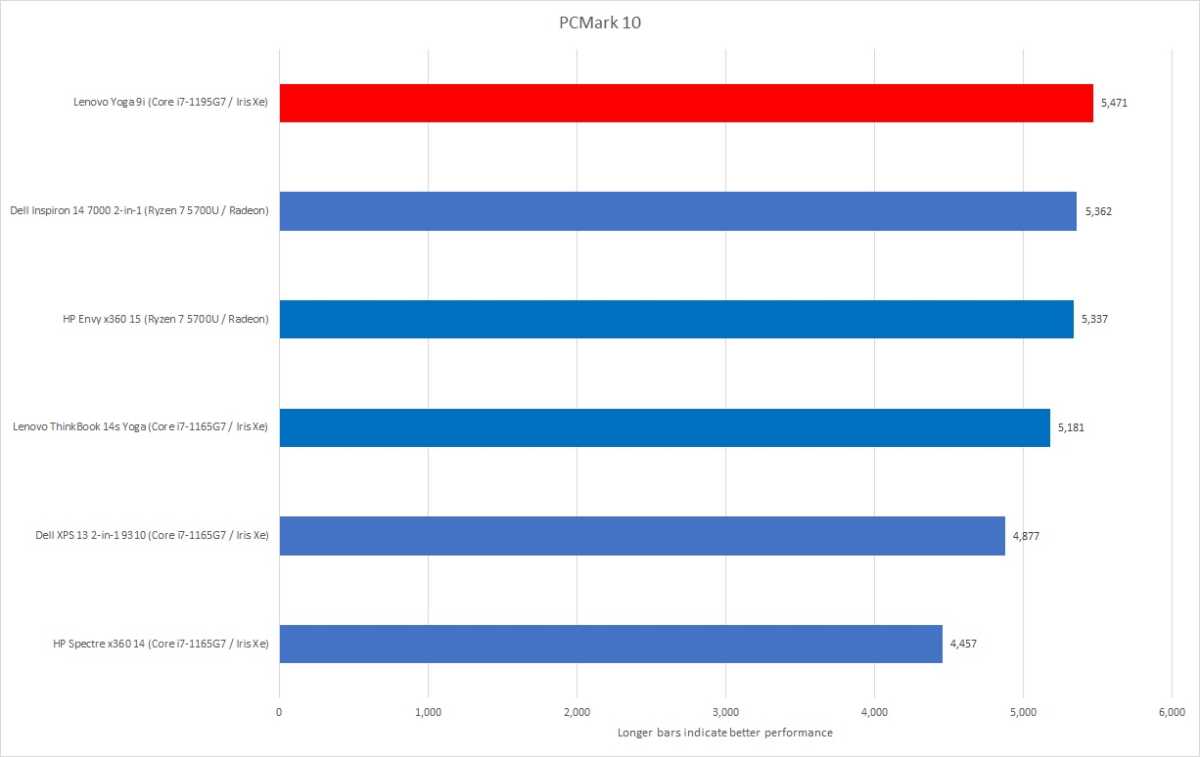
IDG / Matthew Elliott
Our first benchmark is PCMark 10, which measures performance on everyday computing work including office productivity tasks, web browsing, and video chats. The Yoga 9i gets off to a strong start with a first-place finish on PCMark 10. The above 5,000 score indicates that the Yoga 9i is more than equipped to run Office and other productivity apps and handle a variety of multitasking scenarios.

IDG / Matthew Elliott
The Yoga 9i finished ahead of the other Intel machines but behind both AMD systems on our HandBrake test, which involves encoding a large 30GB video file. The Ryzen 7 5700U has double the processing cores and threads as the Yoga 9i’s Core i7-1195G7 chip and allowed the Dell Inspiron 14 7000 and HP Envy x360 15 to finish the test in roughly half the time.

IDG / Matthew Elliott
If our HandBrake test is a marathon, then Cinebench is a sprint. This test renders a complex 2D scene over a short period of time. More processing core and threads also lead to better performance on Cinebench and the two AMD systems are clearly a step or three ahead of the Yoga 9i and the Intel competition.
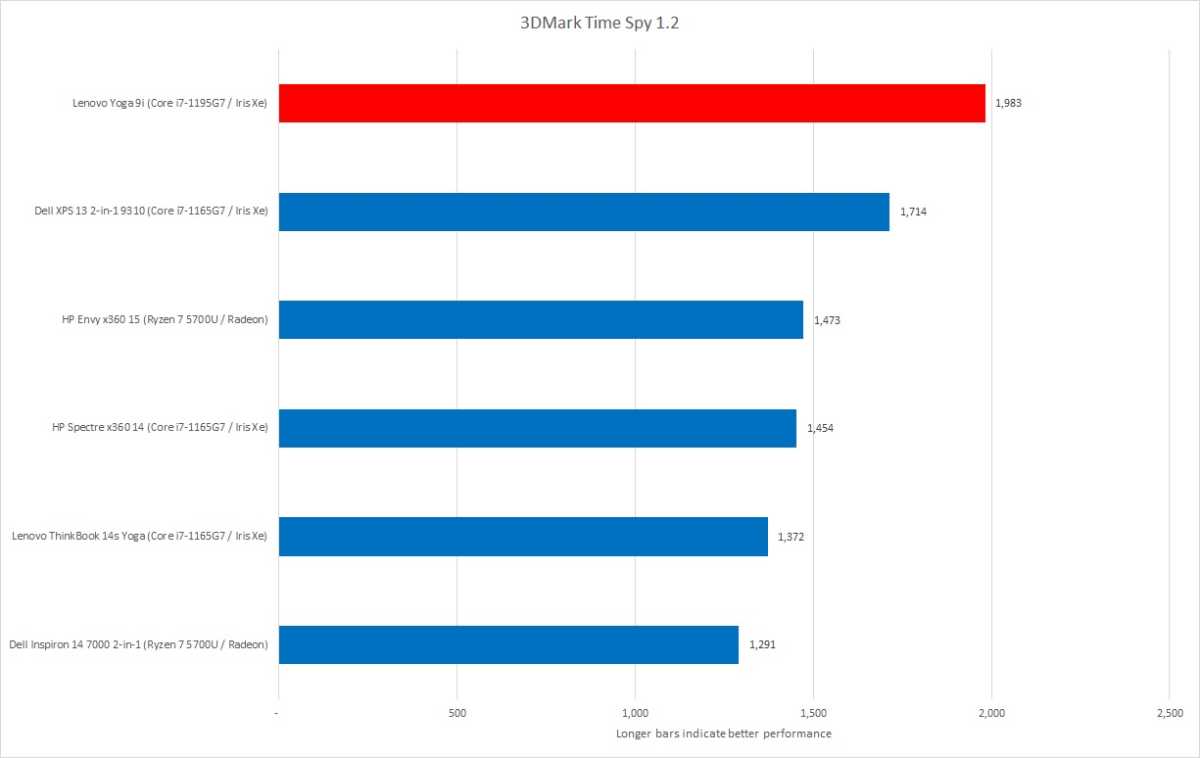
IDG / Matthew Elliott
The Yoga 9i doesn’t offer the best multitasking performance, but it performed admirably on our 3DMark test. A first-place finish among a group of laptops with integrated graphics, however, does not make it a good fit for gamers. Although Intel’s Iris Xe integrated graphics is surprisingly good, as our tests have shown, you’ll need a discrete GPU if you plan to use your laptop for gaming.

IDG / Matthew Elliott
To test a laptop’s battery life, we loop a 4K video using Windows 10’s Movies & TV app with the laptop set to Airplane mode and earbuds plugged in. We set the screen brightness at a relatively bright 250 nits to 260 nits, which is a good brightness for watching a movie in an office with the lights on. The Yoga 9i’s 4-cell, 60 Whr battery lasted nearly 16 hours on our battery-drain test, a hugely impressive result and a longer runtime than other 2-in-1s we’ve reviewed.
Conclusion: Wait for the next update
The Lenovo Yoga 9i has a lot going for it. It really lives up to its premium billing with an all-metal enclosure that is both gorgeous and rock-solid. Its display is bright and vibrant. The innovative speaker bar pumps out impressive sound. The keyboard is roomy and comfortable. The battery runs all day and into the night. As a pure laptop, it’s great. But despite its many charms, I recommend waiting a few months for the updated Yoga 9i to arrive that will introduce a taller, 16:10 screen if you plan on using your laptop in convertible touchscreen form.
This model’s wide 16:9 display feels cramped and awkward in tablet mode. The taller display will let you view more content on the screen with less scrolling and provide more room to juggle open windows when multitasking. It should also feel more natural when you rotate the screen all the way around into tablet mode. The new model will also feature a thicker pen for a more natural grip for drawing and scribbling. The current Yoga 9i is good, but the next version coming soon looks to be even better.




